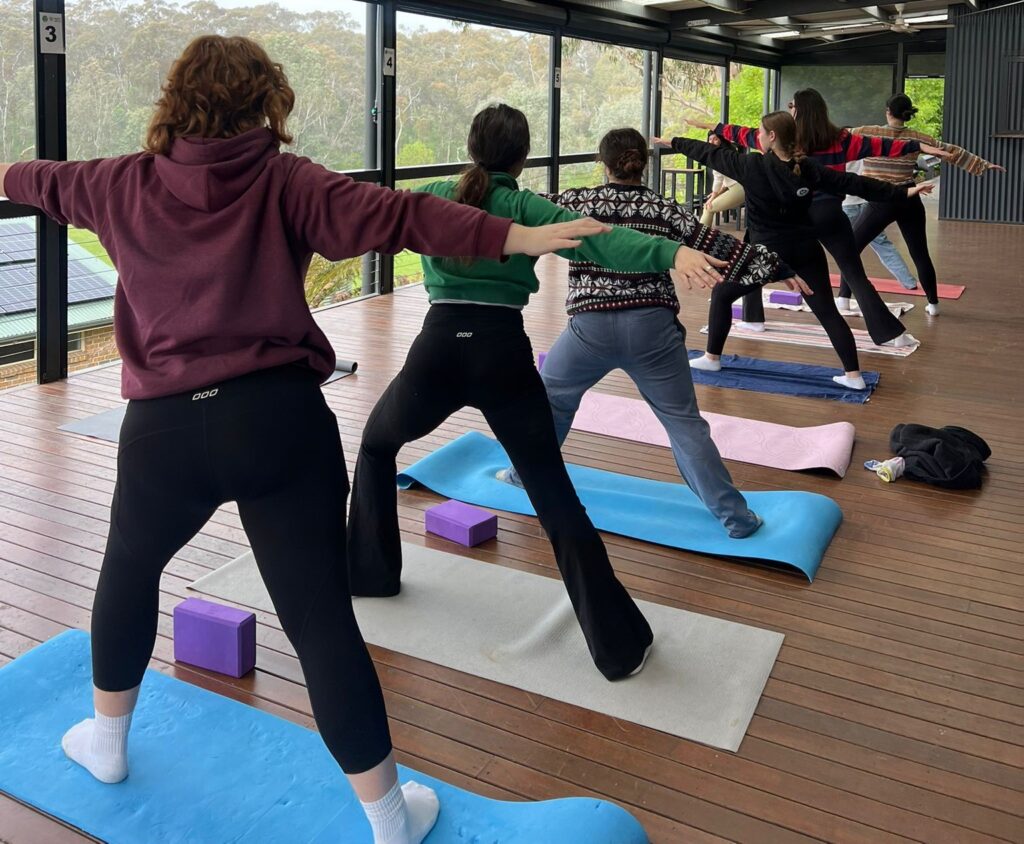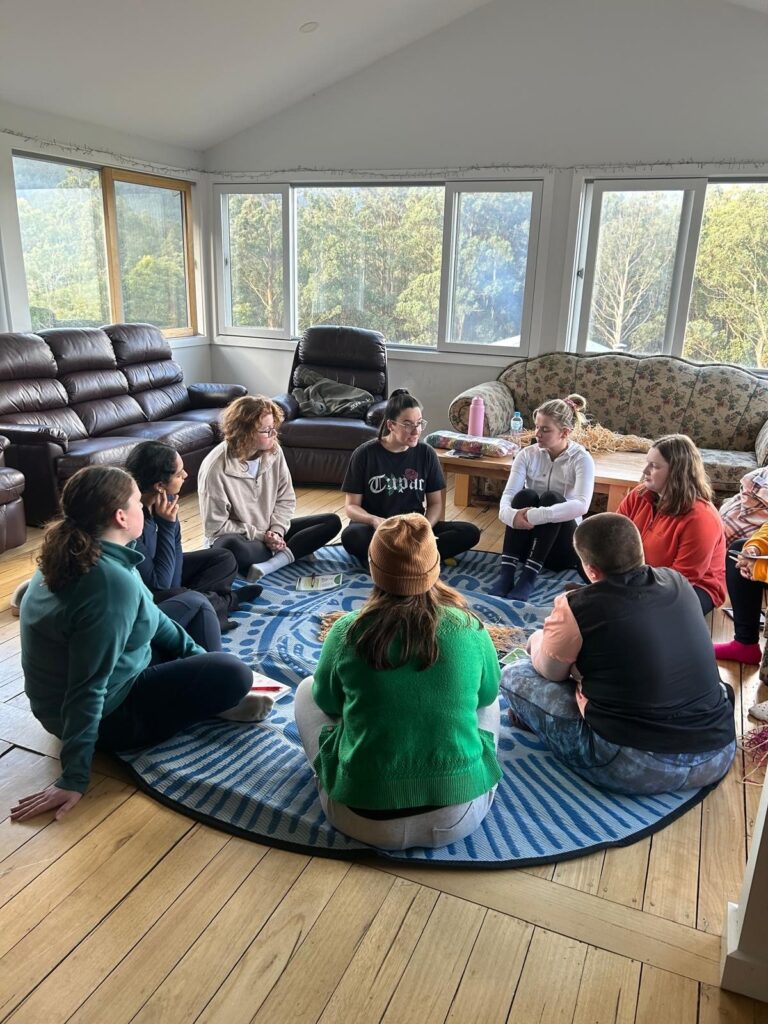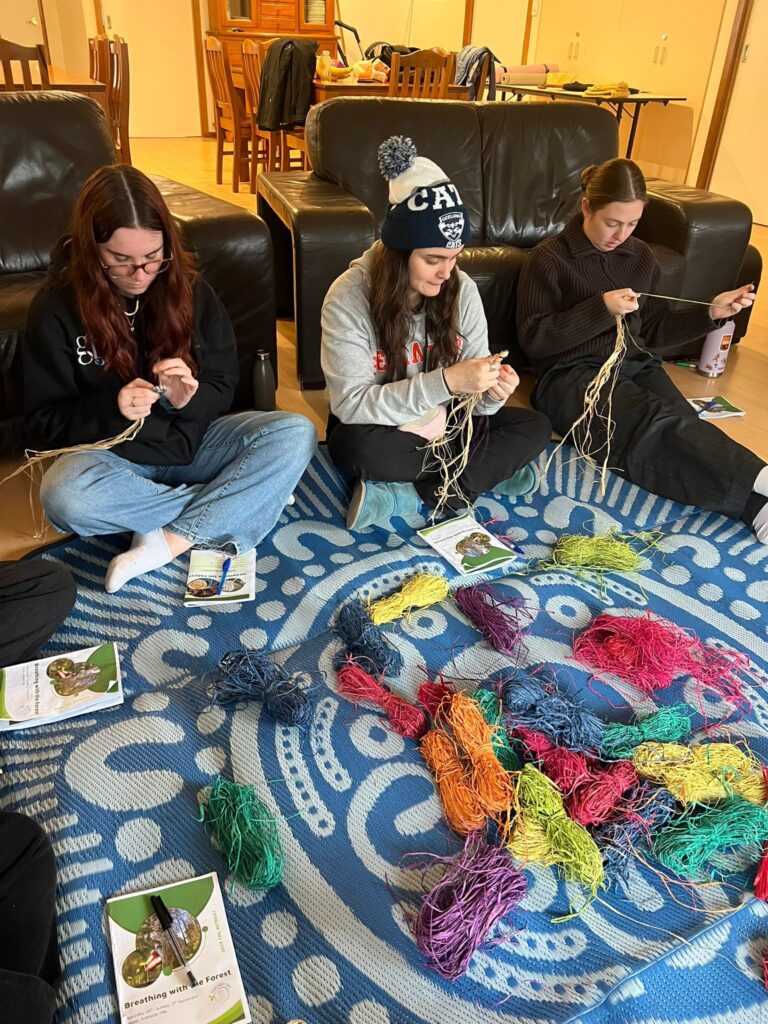Breathing With the Forest
October 31, 2025
Young Mercy Links (YML) recently gathered for our annual retreat. Each year has a different theme and focus, but each gathering we allow ourselves a rare time of quiet reflection and an opportunity for group bonding. It is also a time for extended formation and unpacking Mercy and its relevance in our lives, as well as a time to invigorate and inspire. A time for deep listening, that hopefully turns into plans for action.
This year our theme was ‘Breathing with the Forest’. The Victorian group headed out to Toolangi, about an hour and a half Northeast of Melbourne. ‘Toolangi’ meaning stringy bark tree, is in the lands of the both the Taungurung and Woiwurrung nations. While the South Australian group stayed in the Adelaide Hills, Peramangk country. Both stayed in accommodation enveloped by magnificent trees, and at once noticed how our breathing and heart rate slowed and how the natural landscape calmed our nervous system.
We began our weekend with an opening ritual to ground ourselves in country and to recognise and remember our intimate connection with all of creation. We partook in a virtual experience of ‘Breathing with the Forest’. A multimedia journey that invited us “into relationship with the rhythmic interchange of breath that keeps the forest—and us—alive. Entering the forest, we step out of our separateness to embody something much more than human.” (Emergence Magazine). As we move beyond this experience and back into our daily lives, we encouraged participants to continue a practice of cyclical breathing, giving and receiving with the leafy beings with whom we share the Earth.
“We need to appreciate that both our physical and our spiritual survival depend on the visible world about us. We would have no inner life of mind, imagination or emotion without the wonder, the beauty and the intimacy offered us by the dawn and sunset, the singing birds and the cry of the wolf, by the meadows and all their flowers, by the grandeur of the mountains and the vastness of the sea.” (Thomas Berry 2001: Earthsong Journal)
The next morning, the Victorian group welcomed Juliet Talarico- or more affectionately known to us as Jet. A previous member of YML, an ecology graduate and botanist, who has now started her own facilitation work through her workshops entitled ‘Terra Leaders’. Jet, talked to us about First Nations culture and although not indigenous herself, reminded us that the burden of sharing history and culture should not only fall on the shoulders of First Nations people- we all have a part to play. We embarked on a ‘Listening to the forest walk’ where Jet guided us through the landscape meditatively, informing us of life cycles, plant adaptations and First Nations wisdom around fire and conservation. Similarly, the South Australian group completed their walk through Mylor just southeast of the Warrawong Wildlife Sanctuary. We finished the walk creating our own sensory map including being introduced to indigenous perspectives that encourage us to widen our awareness beyond the typical five understood in western thinking.

After being out in country and amongst the trees, we started the next session with a time lapsed visual recreation of the universe story. Through this session we hoped to move away from a position of ego and understand that we are just one small but impactful part of the ecological web of being. Members were shocked to see the fraction of a second allocated to human existence and reflected on how in such a short time we have had such enormous impact. We also learnt how humans share much of their DNA with more than just primates but every being even back to single cell organisms. Some were even shocked to find out we share 60% of our DNA with bananas.
Moving on from these realisations, we began to grapple with the idea of ecological conversion and what this term actually means. In Laudato Si’, Pope Francis calls us to undergo this process. The Laudato Si’ Movement defines ecological conversion as the “transformation of hearts and minds toward greater love of God, each other, and creation. It is a process of acknowledging our contribution to the social and ecological crisis and acting in ways that nurture communion: healing and renewing our common home.” We came to understand that ecological conversion is about shifting our perception and the lens through which we view not only the world but ourselves. It is about seeing God in and as nature and challenging our visions of God and the language we use to define or characterise “him”.
Members who had previously been on our five day Grampians immersion shared with the group how they view their personal journey of conversion and where they are in that process.
“I feel like my ecological conversion has happened in reverse. It’s through my connection with nature that I formed during childhood that I have been able to deepen my faith and explore other ways to express it in my adult life. Recognising my connection to nature as a very valid expression of faith and having those around me validate it as well has been amazing.” Eve
“I still don’t quite know what mine or even anyone’s ecological conversion should look like. I think it’s something that’s happening without me noticing it to be truthful, it all feels very gradual and natural. To me, it’s just means being more open to nature and thinking about the role that it plays in my life and ultimately what role I want I want to play in its future.” – Grace
“I’ve always had a strong love for the earth and all that it sustains. It has always been where I see and feel the Creator Being most often and most strongly. The movement of ‘The Work that Reconnects Us’, also know as ‘Deep Ecology’, ‘Active Hope’, or ‘Despair and Empowerment’, was an incredibly useful framework for me. Joanna Macy intends to provide us with the courage to continue to act, even in a world that seems hopeless. It also allows us to take time to honour the pain we feel and then to reform that into action for change. That coming together of mourning, faith and call-to-action was particularly powerful for me. In a society that feels as if it is moving more and more towards black and white thinking; false positivity vs. nilism. The work that reconnects helps convert the doomed mentality, that so easily leads to apathy, into kindling for the growing flame of justice within all of us.”- Ruby G
We were also reminded how important this work is, as “it is not enough to have ecological ideas; we have to have an ecological self.” – Arne Naess, Professor of philosophy and deep ecology.
A sister once told me you can’t save what you don’t love and if we see the earth as an extension of ourselves surely, we will be moved to save it. I’m sure she was calling on the work of Thich Nhat Han- Buddhist Monk. “When you realise the Earth is more than simply your environment, you’ll be moved to protect her in the same way as you would yourself.”

After activities that required deep reflection and stretching our perspectives and understandings, we moved onto a communal art activity. We sat together on our yarning mat to learn the diverse and rich cultural practice of aboriginal weaving. This practice deeply rooted in storytelling, connection to country and the transmission of knowledge, has traditionally been female led, with women playing a central role in its creation and transmission. It is a social activity where women gather, share knowledge and strengthen community bonds. During this session we created our own intentions and stitched them into our individual bowls. This was followed by a beautiful onsite yoga session.
We finished off our time together with some forward planning for the next six months, focusing intentionally on ecojustice and First Nations initiative. We also had a touching closing ritual where we affirmed each other and recognised this as a time of Great Turning. This song was a hopeful note to end on as we are surrounded by people doing both the physical work of advocacy and the deeper work of personal ecological conversion. We concluded by going around the circle and finishing of this sentence. At this time of Earth’s great distress I am grateful for…..And after this gathering I am grateful for the community we are building and the young minds and hearts committed to this work.
To find out more – https://institute.mercy.org.au/become-involved/become-a-young-mercy/
